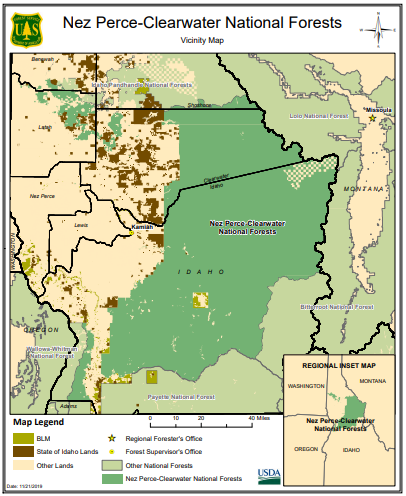If You Care About the Clearwater, Get Involved in Forest Planning
The Nez Perce-Clearwater National Forest provides some of the most spectacular outdoor experiences in north central Idaho. The Salmon and Clearwater rivers form the backbone of Idaho’s salmon and steelhead fishing industry. Beautiful alpine areas provide opportunities to view and hunt mountain goats, one of the state’s most iconic species. Large swaths of roadless and wilderness areas provide for abundant backcountry hunting and fishing opportunities, making it certainly feel like a privilege to live next to 4 million acres of wild, public lands.
Due to a combination of factors, the Forest is struggling with serious declines in some of its most important species. If you hunt or fish in this area, you know we’ve recently experienced some of the worst salmon and steelhead returns on record. Elk populations and harvest have declined since their heyday in the 70s and 80s. IDFG biologists have detected a sharp decline in the iconic Hoodoo/Great Burn mountain goat herd. As the largest landowner in the Clearwater Region, the Forest plays a key role in the persistence of these valuable wildlife species. That’s where Forest Planning comes in.
A Forest Plan is required by law and will guide management actions on the Forest for the next 20-30 years, setting objectives, permissions, and priorities for different management areas across the forest. Objectives and project guidelines included in the forest plan will impact fish and wildlife populations, recreation, and the health of our land and water resources. For residents of north central Idaho, the forest plan also impacts our communities and local economies.
Because of it’s far-reaching nature, the Forest Plans must go through an extensive review process that includes public comment. We encourage sportsmen to review the draft plan (the executive summary is helpful and only 20 pages) and submit comments online here. Comments must be submitted by April 20, 2020 for full consideration, but the Forest will accept comments at any time.
You can also review IWF’s full set of comments by clicking on the button below, which cover many issues that impact wildlife and hunting/fishing opportunity in depth. However, feel free to make your comment as short or as long as you want. Make sure you include your concerns as well as things you support and to communicate your values around hunting, fishing, or trapping on the Forest. While the draft plan includes five alternatives, you don’t have to choose just one to support. Feel free to mix and match different components.
Key issues
The Hoodoo and Mallard-Larkins should remain Recommended Wilderness Areas.
These areas both contain mountain goat herds, which are sensitive to motorized recreation. IDFG recognizes illegal snowmobile use as an issue for the declining Hoodoo herd. Removing protections, including a boundary change in the Hoodoo under Alternative Y, would expose goats to increased levels of disturbance during the critical winter period and potentially exacerbate declines.
Increased timber harvest is good for elk, but management practices must be sustainable.
All of the action alternatives in the draft plan propose increased timber harvest levels to attain historical vegetation characteristics and increase summer forage for elk. We support the Forest’s approach, but Alternatives W and X propose unsustainable levels of harvest that would threaten wildlife security habitat and watershed health. They would also hurt local economies by perpetuating the “boom-and-bust” timber economy. Instead, a gradual acceleration of timber output to a sustainable level would benefit wildlife and surrounding communities.
Good protections for fish, including some key Wild and Scenic River designations.
The plan cements standards and guidelines that will effectively mitigate impacts of timber harvest on salmon, steelhead, and bull trout. This is important because the Forest contains a huge amount of critical salmonid spawning and rearing habitat, including some streams that may serve as refuges during climate warming. Alternatives W, Y, and Z also propose protecting important salmon and steelhead streams under the Wild and Scenic Rivers Act, including John’s Creek, Fish Creek, Cayuse Creek, Weitas Creek, and Meadow Creek.
Once again, the Feds failed to evaluate the contributions of sportsmen.
Just like the recent Columbia River Draft Environmental Impact Statement, and despite the availability of public data, the draft plan failed to evaluate the economic contributions of sportsmen in the Economic Sustainability section. In fact, the only industry that received any analysis at all was the timber industry, despite the plan’s emphasis on improving elk and fish populations. The Forest needs to revise this analysis with publicly available data and expert input on the economic impacts of the sporting industry so decision makers can accurately evaluate the plan’s impact on all sectors.

